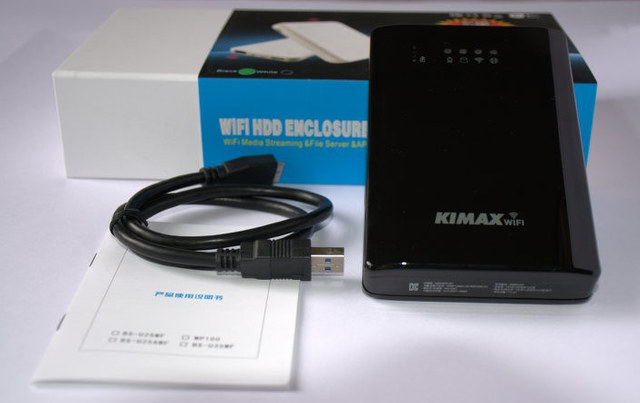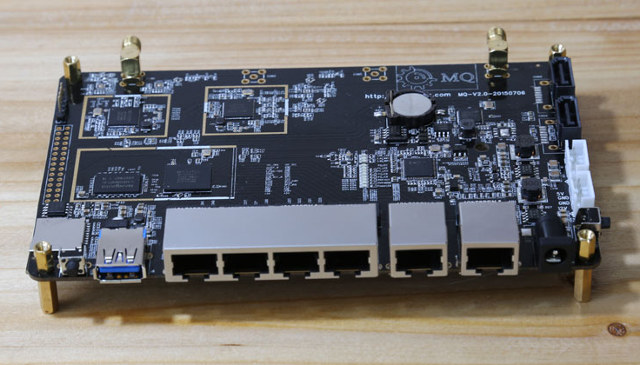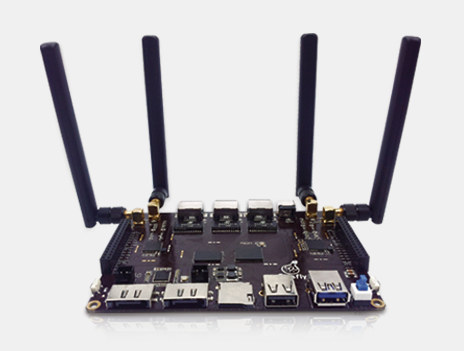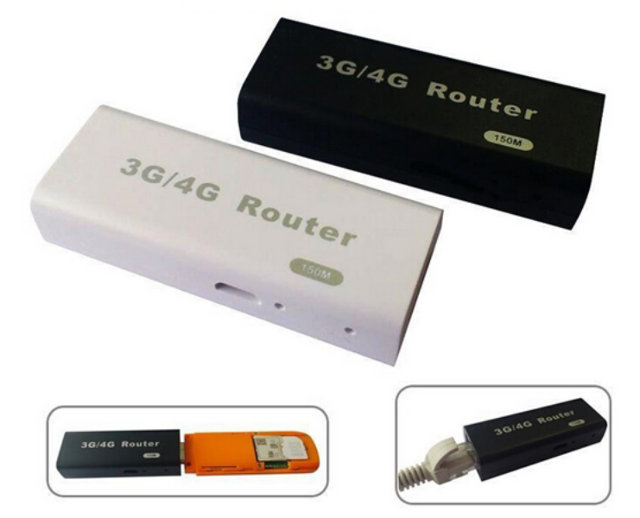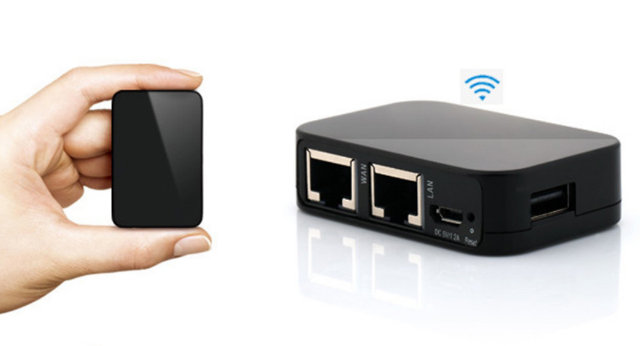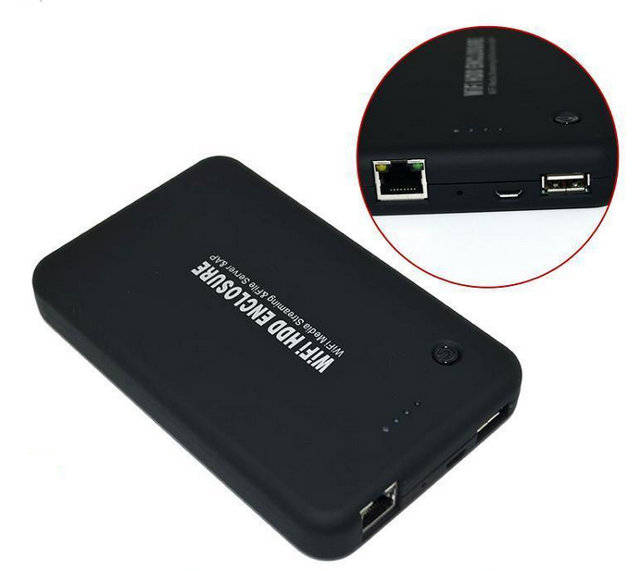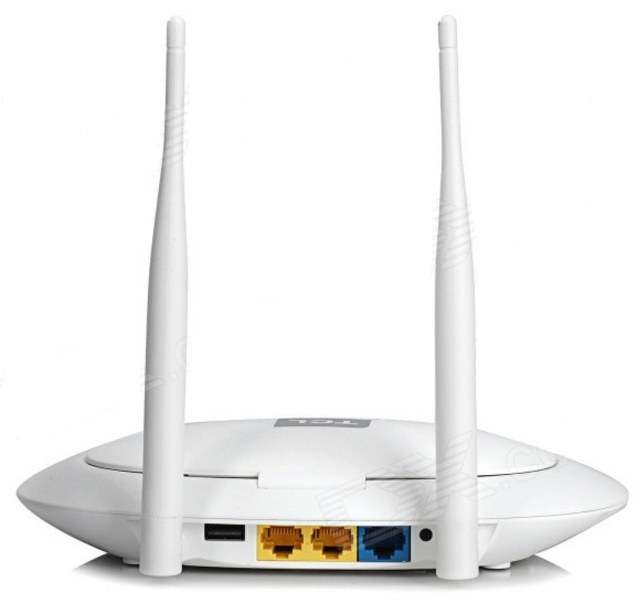Google has just announced OnHub, a $200 router designed in cooperation with TP-Link which the company claims will be “fast, secure, and easy to use”. It should indeed be fast as it’s a Class AC1900 router capable of 600 Mbps with 802.11n and 1300 Mbps with 802.11ac. Router are gateways between home networks and the Internet, but most of them aren’t updated automatically, leaving them vulnerable to attacks, while OnHub should get its firmware regularly updated over-the-air and include a Trusted Platform Module (TPM), making it more secure. Finally, Android and iOS apps are available to easily manage the router. OnHub (TGR1900) router specifications: WiSoC – Qualcomm Atheros IPQ8064 dual core Krait processor @ 1.4 GHz System Memory – 1GB DDR3L Storage – 4GB eMMC, 8MB NOR flash Connectivity 802.11 b/g/n 3×3 with smart antenna 802.11 a/n/ac 3×3 with smart antenna AUX wireless (802.11 a/b/g/n/ac 1×1) – I don’t understand […]
Updated Ethernet & WiFi HDD Enclosure Supports 300Mbps with Mediatek MT7620N Processor
I featured an HDD enclosure with WiFi and Ethernet on CNX Software a few months ago, and several people were interested, bought one, and found out it was running OpenWRT, and easily to adapt to your needs, although some people complains it was not able to connect as a client. There’s now a new model, looking similar, by powered by Mediatek MT7620N and supporting 300 Mbps WiFi. While hardware specifications were not published with the first model, the manufacturer decided to release the full specifications for the new model: Processor – Mediatek MT7620N MIPS processor @ 580 MHz System Memory – 64MB DDR1 Storage 16MB SPI flash for firmware SATA interface for 2.5″ HDD up to 2TB (10TB is shown in the description) File systems – FAT32, NTFS, EXT64 (Sic.). Connectivity 2.4GHz WiFi 802.11 a/b/g/n 2×2 up to 300 Mbps with 2 internal antennas Wireless security – WPA-PSK/WPA2-PSK/AES encryption, Intelligent […]
WiTi OpenWRT Router Board Features 6 Ethernet Ports, Dual Band WiFi, SATA and USB 3.0 Ports (Crowdfunding)
If you thought FireWRT router board had impressive features and but still wanted more, a new product is coming soon. WiTi is also a board powered by Mediatek MT7621A dual core processor @ 880MHz, but with 4 Gigabit Ethernet LAN ports, 2 Gigabit WAN ports, 802.11 b/g/n and 802.11ac WiFi with up to 4 external antennas, two SATA ports, as well as a USB 3.0 port. WiTi board specifications: Processor – Mediatek MT7621A dual core (4 threads) MIPS 1004Kc processor @ 880Mhz System Memory – 256MB Memory (up to 512MB later) Storage – 16MB SPI NOR flash for firmware, 1x micro SD slot, and 2x SATA 3.0 ports supporting 3.5″ hard drives. There’s also an optional NAND flash (not included in any Indiegogo rewards) Connectivity 2.4 GHz WiFi 802.11b/g/n up to 300Mbps 5 GHz WiFi 802.11a/n/ac up to 867Mbps 2x Gigabit Ethernet WAN ports 4x Gigabit Ethernet LAN ports 4x RF Antenna […]
FireWRT is an OpenWRT 802.11ac Board Powered by Mediatek MT7621A Processor
There are plenty of low cost 802.11n routers or boards supporting OpenWRT, even starting at $10 or less such as A5-V11 mini router, but if you’re looking for something a bit more powerful with 802.11ac connectivity, options are much more limited, especially if you need something at a lower cost. One option is Xiaomi MiWiFi router based on Mediatek MT7620A with 64MB RAM, and T-Firefly team is now working on FireWRT board based on the more powerful MT7621A processor coupled with 512 MB RAM, and 16 MB SPI flash. FireWRT specifications: Wi-Fi SoC – Mediatek MT7621A dual core MIPS 1004Kc processor @ 880MHz System Memory – 512 MB DDR3 (Beta version: 256 MB) Storage – 16 MB SPI flash memory, 2x SATA 3.0 ports, micro SD card slot Wi-Fi 802.11 b/g/n @ 2.4GHz up to 300Mbps 802.11 a/n/ac @ 5 GHz, up to 867Mbps (AC1200 class router) External High-Gain Antennas […]
A5-V11 Mini Router Runs OpenWRT (Linux) For Just $8
In case you you still think OpenWRT capable NEXX WT1520 router is still too expensive at $15, what about an $8 OpenWRT router? That’s what LY mini wireless router costs including shipping, and it’s better known as A5-V11, the name of its PCB. It’s not exactly a 3G/4G router as the casing implied, but it does support external USB 3G/4G dongles like most other routers with USB on the market. A5-V11 specifications: SoC – Mediatek/Ralink) RT5350F MIPS processor @ 360MHz System Memory – 32MB RAM (W9825G6EH-75). Some people reported theirs only have 16MB RAM, so YMMV. Storage – 4MB NAND flash (Pm25LQ032) Connectivity – Wi-Fi 802.11b/g/n up to 150 Mbps; 1x 10/100M Ethernet USB – 1x USB 2.0 host port, 1x micro USB port for power Misc – Power LED, factory reset pinhole Power – 5V via micro USB port Dimensions – 6.1 x 2.3 x 1.4 cm Contrary to […]
$15 NEXX WT1520 Wi-Fi Router Supports OpenWRT
TP-Link WR703N is a popular low cost router well supported by OpenWRT that costs about $23 shipped. But there’s now a new cheaper router that’s been mentioned in comments on CNX Software a few times, with a different processor, but otherwise similar specs plus an extra Ethernet port. NEXX WT1520 is powered by Mediatek RT5350F, sells for $15 including shipping from sites like Banggood, Aliexpress and eBay, and can run OpenWRT, although it’s not officially supported yet. NEXX WT1520(F/H) specifications: SoC – Mediatek (previously Ralink) RT5350F MIPS processor @ 360MHz System Memory – 32MB RAM Storage – 4MB NAND flash Connectivity: Wi-Fi 802.11b/g/n up to 150 Mbps with built-in PIFA antenna 2x 10/100M Ethernet (LAN and WAN) USB – 1x USB 2.0 host port, 1x micro USB port for power Misc – Status LED, reset pinhole, power button Power – 5V via micro USB port Dimensions – 63 x 43 […]
Add Network Connectivity to 2.5″ SATA Drives With Wi-Fi & Ethernet Enclosures
One person asked if there were solution to add Wi-Fi or Ethernet to hard drives similar to what Zsun Wifi Card Reader does with micro SD card. Provided solution include buying a low cost router with USB such as TP-Link WR703N, and the Pogoplugs which are pretty good, especially since you can install Debian or Arch Linux ARM, but are only available at low cost if you live in North America. But I’ve now been made aware of 2.5″ SATA HDD enclosures selling for around $40 that also come with Wi-Fi and Ethernet, and provide a compact way to add networking to hard drives. Specifications for the aforelinked Wi-Fi HDD Enclosure: Connectivity 802.11 a/b/g/n Wi-Fi. Modes: AP + Client; AP + WAN Bridge; AP + WAN router Ethernet 3G possible via USB port HDD – Supports up to 2TB HDD USB – 1x micro USB port for charging, 1x USB […]
TCL T1 (SL-WR5028J) is a $46 Wi-Fi Router with a 2.5″ SATA Bay
Many routers now come with one or more USB ports to let you connect 3G dongles or/and storage device(s) to share the data on your local network. If you want to go with a fully integrated solution, and obvious solution is to go with a NAS, but these usually cost a bit more, so instead TCL SL-WR5028J (aka TCl T1) router could make a low cost (and low performance) NAS alternative thanks to its internal 2.5″ SATA bay, and it can be had for just $45.99 on DealExtreme. [Update: GearBest sells it for $35.98 with coupon TCLT1] TCL T1 specifications: SoC – Mediatek MT7260 MIPS WiSoC @ 580MHz System Memory – 64MB DDR2 Storage – 8MB Flash for firmware + SATA bay for 2.5″ HDD (5, 7.5 or 9mm thick hard drives are supported). Max capacity: unlimited… 🙂 Connectivity 802.11 b/g/n Wi-Fi up to 300 Mbps with two external antennas […]



